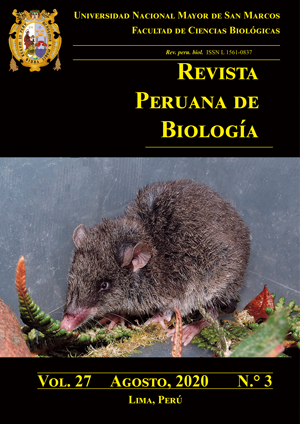Ethnozoological study of wild vertebrates of the Bonifacio Garcia community, Morelos, Mexico
DOI:
https://doi.org/10.15381/rpb.v27i3.17080Keywords:
Appropriation, subsistence hunting, traditional knowledge, wild fauna, use valuesAbstract
The aim of this study was to analyze the ethnozoological knowledge that the inhabitants of the Bonifacio García community, Morelos, Mexico, conserve about wild vertebrate. Semi-structured interviews were applied to 30 key informants, through participant observation and guided tours, traces such as footprints, excreta, burrows and pelts and in vivo observation were researched for the identification of the mentioned species and the following indexes were calculated: value of diversity of use for each species (VDS) and of medicinal uses (DVM), as well as the diversity index of the treated diseases (DITD). The study recorded a total of 42 wild vertebrate species, of these 28 are used: mammals 39.3%, birds 32%, reptiles 18%, fish 7.1% and amphibia 3.6%. The main use values were alimentary (0.54), medicinal (0.46) and ornamental (0.43). The white-tailed deer, the black iguana and the rattlesnake registered 0.57 of VDS and a DVM of 0.19. The main diseases treated are cancer, respiratory and skin diseases and rheumatism with an DITD of 0.17. The animals are obtained by means of subsistence hunting in the fields (50%), croplands (43%) and backyards (7%), using most frequently shotguns as arms for capture. We conclude that the appropriation of vertebrates complements basic needs for food and health; therefore, ethnozoological knowledge must be integrated into public policies that enable the conservation and management of wild fauna in the community.
Downloads
Downloads
Published
Issue
Section
License
Copyright (c) 2020 ALEJANDRO GARCÍA FLORES

This work is licensed under a Creative Commons Attribution-NonCommercial-ShareAlike 4.0 International License.
AUTHORS RETAIN THEIR RIGHTS:
a. Authors retain their trade mark rights and patent, and also on any process or procedure described in the article.
b. Authors retain their right to share, copy, distribute, perform and publicly communicate their article (eg, to place their article in an institutional repository or publish it in a book), with an acknowledgment of its initial publication in the Revista Peruana de Biologia.
c. Authors retain theirs right to make a subsequent publication of their work, to use the article or any part thereof (eg a compilation of his papers, lecture notes, thesis, or a book), always indicating its initial publication in the Revista Peruana de Biologia (the originator of the work, journal, volume, number and date).






